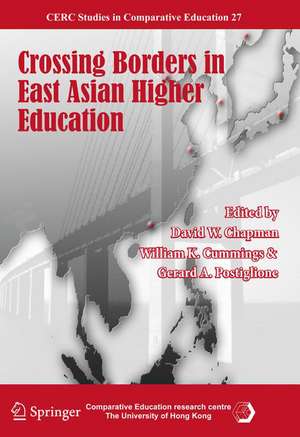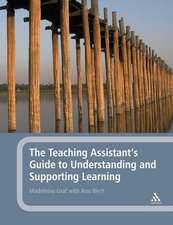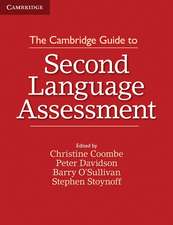Crossing Borders in East Asian Higher Education: CERC Studies in Comparative Education, cartea 27
Editat de David W. Chapman, William K. Cummings, Gerard A. Postiglioneen Limba Engleză Hardback – 5 noi 2010
Din seria CERC Studies in Comparative Education
- 18%
 Preț: 1246.72 lei
Preț: 1246.72 lei - 15%
 Preț: 645.60 lei
Preț: 645.60 lei - 18%
 Preț: 952.26 lei
Preț: 952.26 lei - 18%
 Preț: 1328.05 lei
Preț: 1328.05 lei - 15%
 Preț: 643.99 lei
Preț: 643.99 lei - 18%
 Preț: 956.50 lei
Preț: 956.50 lei - 18%
 Preț: 952.40 lei
Preț: 952.40 lei - 18%
 Preț: 953.82 lei
Preț: 953.82 lei - 18%
 Preț: 955.70 lei
Preț: 955.70 lei - 15%
 Preț: 646.11 lei
Preț: 646.11 lei - 18%
 Preț: 952.40 lei
Preț: 952.40 lei - 18%
 Preț: 1401.30 lei
Preț: 1401.30 lei - 18%
 Preț: 954.62 lei
Preț: 954.62 lei - 18%
 Preț: 953.82 lei
Preț: 953.82 lei - 24%
 Preț: 1162.20 lei
Preț: 1162.20 lei - 18%
 Preț: 1222.01 lei
Preț: 1222.01 lei - 24%
 Preț: 812.86 lei
Preț: 812.86 lei - 15%
 Preț: 644.18 lei
Preț: 644.18 lei - 15%
 Preț: 647.27 lei
Preț: 647.27 lei - 15%
 Preț: 648.74 lei
Preț: 648.74 lei - 15%
 Preț: 645.47 lei
Preț: 645.47 lei - 18%
 Preț: 900.94 lei
Preț: 900.94 lei - 18%
 Preț: 952.72 lei
Preț: 952.72 lei
Preț: 585.60 lei
Preț vechi: 732.00 lei
-20% Nou
Puncte Express: 878
Preț estimativ în valută:
112.05€ • 116.99$ • 92.74£
112.05€ • 116.99$ • 92.74£
Carte tipărită la comandă
Livrare economică 31 martie-07 aprilie
Preluare comenzi: 021 569.72.76
Specificații
ISBN-13: 9789400704459
ISBN-10: 9400704453
Pagini: 408
Ilustrații: XVI, 388 p. 3 illus.
Dimensiuni: 170 x 250 x 30 mm
Greutate: 0.82 kg
Ediția:2011
Editura: SPRINGER NETHERLANDS
Colecția Springer
Seria CERC Studies in Comparative Education
Locul publicării:Dordrecht, Netherlands
ISBN-10: 9400704453
Pagini: 408
Ilustrații: XVI, 388 p. 3 illus.
Dimensiuni: 170 x 250 x 30 mm
Greutate: 0.82 kg
Ediția:2011
Editura: SPRINGER NETHERLANDS
Colecția Springer
Seria CERC Studies in Comparative Education
Locul publicării:Dordrecht, Netherlands
Public țintă
ResearchCuprins
List of Abbreviations.- List of Tables.- List of Figures.- Foreword: Philip G. Altbach.- 1. Transformations in Higher Education: Crossing Borders and Bridging Minds: David W. Chapman, William K. Cummings & Gerard A. Postiglione.- Part I: Issues and Perspective .- 2. East Asian Knowledge Systems: Driving Ahead Amid Borderless Higher Education: Gerard A. Postiglione.- 3. Is the Academic Center Shifting to Asia? William K. Cummings.- 4. China’s Universities, Cross-Border Education, and Dialogue Among Civilizations: Ruth Hayhoe & Jian Liu.- Part II: China’s Global Adaptations.- 5. Adaptation of Globally Held Ideas about Research in China’s Universities: Brian Yoder.- 6. Educational Exchanges: What China Should Not Adopt fromUnited States Higher Education: Kathryn Mohrman.- 7. China’s Scholarship Program as a Form of Foreign Assistance: Lili Dong & David W. Chapman.- 8. Attitudes and Motivation in Second-Language Acquisition: A Study of International Students in China from a Cultural Perspective: Baohua Yu & David Watkins-. Part III: National Experiences .- 9 Japan’s Internationalization of Higher Education: A Response To the Pressures of Globalization: Akira Arimoto.- 10. Korea’s Internationalization of Higher Education: Process, Challenge and Strategy: Eun Young Kim & Sheena Choi.- 11. Borders Bridging Degrees: Harbin and Vladivostok’s Dual-Degree Programs: Andrey Uroda.- Part IV: Comparative National Experiences.- 12. Transnational Higher Education in Japan and China: A Comparative Study: Futao Huang.- 13. Internationalizing Universities: Comparing China’s Hong Kong And Singapore (1996-2006): Michael H. Lee.- Part V: The Hong Kong Crossing.- 14. Borders crossing and Market Integration: Mainlan Consumers Meet Hong Kong Suppliers: Mei Li.- 15. Adaptation of Mainland Postgraduate Students to Hong Kong’s Universities: Min Zeng & David Watkins.- Part VI: Conclusion.- 16. East Asia’s Experience of Border Crossing: Assessing Future Prospects: GerardPostiglione & David W. Chapman. Notes on the Authors.
Notă biografică
David W. CHAPMAN is the Birkmaier Professor of Educational Leadership in the Department of Organizational Leadership, Policy, and Development in the College of Education and Human
Development at the University of Minnesota. He has worked in more than 45 developing countries, assisting national governments and international organizations in the areas of educational policy and planning, program design and evaluation. The author of over 125 journal articles and book chapters, he was awarded a Fulbright New Century Scholars grant for the 2007-08 academic year.
William K. CUMMINGS is Professor of International Education and International Affairs at George Washington University. He has been involved in development work for over 25 years, focusing on evaluation and monitoring, policy analysis, sector assessment, management analysis, and teacher
training. He has written extensively on the challenges of development and on models of successful development strategies, and has written or edited over 100 articles and 20 books or monographs. He is a past president of the Comparative and International Education Society.
Gerard A. POSTIGLIONE is Professor and Head of the Division of Policy, Administration and Social Sciences Education, and Director of the Wah Ching Centre of Research on Education in
China, in the Faculty of Education at the University of Hong Kong. He has published 10 books and over 100 journal articles and book chapters. He has worked on higher education projects for the Asian Development Bank, the United Nations Development Programme, the World Bank, the Carnegie Foundation for the Advancement of Teaching, the Ford Foundation, and the Institute of International Education.
Development at the University of Minnesota. He has worked in more than 45 developing countries, assisting national governments and international organizations in the areas of educational policy and planning, program design and evaluation. The author of over 125 journal articles and book chapters, he was awarded a Fulbright New Century Scholars grant for the 2007-08 academic year.
William K. CUMMINGS is Professor of International Education and International Affairs at George Washington University. He has been involved in development work for over 25 years, focusing on evaluation and monitoring, policy analysis, sector assessment, management analysis, and teacher
training. He has written extensively on the challenges of development and on models of successful development strategies, and has written or edited over 100 articles and 20 books or monographs. He is a past president of the Comparative and International Education Society.
Gerard A. POSTIGLIONE is Professor and Head of the Division of Policy, Administration and Social Sciences Education, and Director of the Wah Ching Centre of Research on Education in
China, in the Faculty of Education at the University of Hong Kong. He has published 10 books and over 100 journal articles and book chapters. He has worked on higher education projects for the Asian Development Bank, the United Nations Development Programme, the World Bank, the Carnegie Foundation for the Advancement of Teaching, the Ford Foundation, and the Institute of International Education.
Textul de pe ultima copertă
This book examines issues that have emerged as higher education systems and individual institutions across East Asia confront and adapt to the changing economic, social, and educational environments in which they now operate. The book' s focus is on how higher education systems learn from each other and on the ways in which they collaborate to address new challenges. The sub-theme that runs through this volume concerns the changing nature of cross-border sharing. In particular, the provision of technical assistance by more industrialized countries to lower and middle income countries has given way to collaborations that place the latter' s participating institutions on a more equal footing. At the same time, there is a greater number of partnerships that link higher education systems in the East Asian region to one another. Even as boundaries become more porous and permeable, there is growing acceptance of the view that cross border collaboration, if done well, can offer mutually beneficial advantages on multiple levels. There is a new recognition that the intensified international sharing of ideas, strategies of learning, and students is not only of enormous value to systems and institutions but essential to their long term survival. To this end, the chapters in this volume examine various motivations, goals, mechanisms, outcomes and challenges associated with cross-border collaboration in higher education.
Crossing Borders in East Asian Higher Education was awarded 1st place in the Annual Comparative and International Education Society's Higher Education SIG in the category Best in Book for 2009-2010 academic year.
Crossing Borders in East Asian Higher Education was awarded 1st place in the Annual Comparative and International Education Society's Higher Education SIG in the category Best in Book for 2009-2010 academic year.
Caracteristici
This volume examines various motivations, goals, mechanisms, outcomes and challenges associated with cross-border collaboration in higher education A remarkable study of the delivery of citizenship education across the region Written by experts











